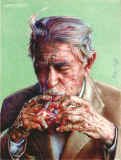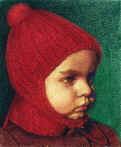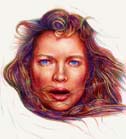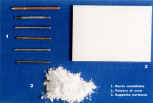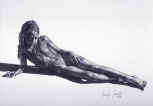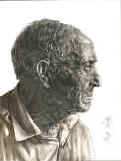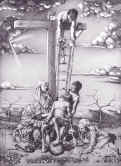It is at the beginning
of the 16th Century that Leonardo Da Vinci draws the Angel "from the
impalpable smile" with a silver point (fig.1) - or perhaps
with a golden point - kept in the Royal Library of Turin and other works
that confirm what Cennino Cennini had said in 1300 : drawing is the
milestone of Art. It is an autonomous genre, a divine speculation, which
turns into painting as soon as it is decided by the artist. Giuseppe
Borrello, moved to Turin where he has lived since 1979. A talented artist
capable of using different techniques, he turns his signs into colour by
means of silver, golden, titanium and platinum points and a special paper
prepared on purpose (fig.2). Thanks to a process of natural
oxidation Borrello obtains amber-coloured tonalities where the silver
point has been used.
This is the origin of
a peculiar group of works such as "Carmen" (fig.3), a
nude whose lifelikeness is due to the particular shadows, or other showing
old people's heads where the lines, the beards, the tufts of hair and the
anatomical details reveal the love for the Flemish Renaissance, or
sleeping models, or a beautiful child who epitomized innocence.
The portrait of
"Uncle Castore" (fig.4) is obtained instead by using a
palladium point.
Giuseppe Borrello - son of a sculptor-was born in Sant' Agata di Esaro (Cosenza), a place which is often portrayed by the artist with its paths, decrusted walls, small staircases and narrow windows standing as witnesses of hidden presences beyond the walls of the old houses.
Like all the people from the
South, the painter is deeply fond of his family. This is why many of his
relatives can be recognized in his big cartoons - mainly showing religious
subject-painted with the biro technique. These works are antique and
innovative at the same time and express the artist's passion and desire to
turn dreams into reality.
Fig.1. Leonardo da Vinci - Studio di mani
femminili.
Fig.2. Strumenti di lavoro.
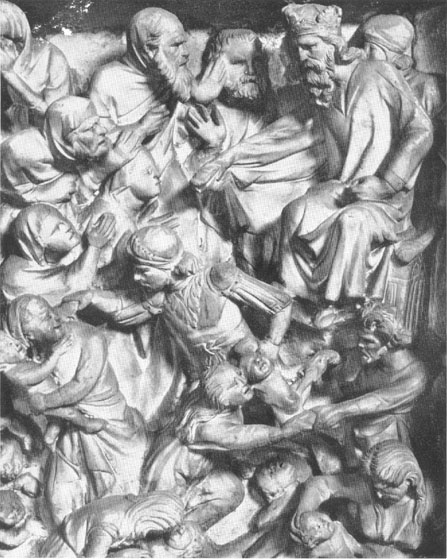
Fig.6. Giovanni Pisano - Strage degli Innocenti.
Fig.7(in basso). G. Borrello - Strage gegli Innocenti - 1990
Fig.3. G.Borrello - Carmen - 1992
Fig.4. G. Borrello - Zio Castore - 1994
Fig.5. G. Borrello - Deposizione - 1983
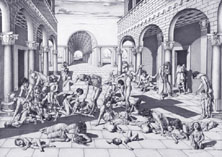
In the
"Deposition” (fig.4) (1983, cm 100x70) we find again faces dear to
the artist that represent a throng of feelings, symbols and careful
naturalistic quotations. In a landscape where the bare trees are dominated
by a ray of hope, we can see the cross, the staircase and the apostle who
is lowering Jesus's corpse after his last breath of life before the pious
women whose faces can be guessed behind the veils of Flemish memory.
"The Slaugther of the Innocents" is a tragic representation. The
image of the slaughterer who lifts the little child holding him by the
foot reminds of Giovanni Pisano's paintings (fig.5 and 6), whereas
"Apocalypse of the Year Two Thousand" (fig.7) could be the title
of the work presented as "Untitled" in 1982. It represent the
ipact with the great city, its misteries, its moral and physical shadows,
the sense of loneliness that originates from it. Lonely and desperate are
especially the women painted here, prostrated before an altar dominated by
the shining image of Christ or lying abandoned on the steps of a church
brightened by metaphysical lights.
But the biro technique
is easily translated into colour; that is the way the image of
"Fabiola" (fig.8)is created, a maiden with an amber - coloured
face, wrapped in a glittering mantle, whose eyes the artist has created
"Medusa"(fig.9) - a modern interpretation of an antique subject
- the portrait of Mario Soldati (fig.10) and "My Daughter “
(fig.11), a pastel showing a sulky little girl with a woolen cap on her
head.
These are only
fragments of the wide production of Borrello, who was already labelled ten
years ago by the Mondadori catalogue as "the only well-known artist
capable of using a particular stroke of the biro pen." This is a
modern means of expression that lets the artist create paintings which
taste of antique.
Exhibition c/o Arteincornice Turin, 23 march 1996 G.G.Massara
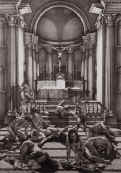
Fig.8. G.Borrello - Apocalisse Duemila - 1982
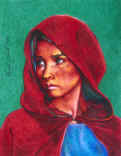
Fig.9. G. Borrello - Fabiola - 1994
